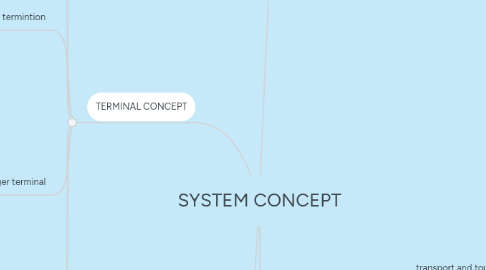
1. TERMINAL CONCEPT
1.1. any facilitiy where freight and passenger are or dispersed
1.2. Terminal requirement
1.2.1. consumer
1.2.1.1. meet consumer requirement
1.2.2. community
1.2.2.1. located near the community
1.2.3. economic
1.2.3.1. the employment,payroll and local expenditure of all organization
1.2.4. future expansion
1.2.4.1. increase the capacity build and upgrade the existing terminal
1.2.5. operational
1.2.5.1. terminal through the system control pf passenger
1.3. principal termintion
1.3.1. permit easy interchange and transfer
1.3.2. Facilitate consolidation
1.3.3. No congestion factor
1.3.4. concentration
1.4. passenger terminal
1.4.1. require relatively little specific equipment
1.4.2. services such as information ,shelter,food and security are required
1.4.3. appear congested at certain times of the day
1.4.4. example of passenger terminal
1.4.4.1. airport
1.4.4.2. terminal activity measurement
1.4.4.2.1. generally starightforward,comman indicator is the number of passanger handled,differentiated according to arrival the depatures,
1.5. passenger transport
1.5.1. Divided into public and private transport ,public is schedule services on fixed routes,short distance transport is dominated by the automobile and mass transit.
1.6. freight terminal
1.6.1. specific loading and unloading equipment
1.6.1.1. bulk
1.6.1.2. general cargo
1.6.1.3. Terminal Activity Measurement
1.6.1.3.1. Bramen rules
1.6.1.3.2. Antwerp rule
2. Just in time
2.1. principle of getting the right material to the right place and at the right time
2.2. benefits
2.2.1. dramatically improved inventory turnover
2.2.2. productivity improvement and greater control between various production stage
2.2.3. waste reduction
2.2.4. a reduction in manufacturing cycle time
2.3. problems
2.3.1. not so suitable for all firm
2.3.2. supplier locations
3. Transport and logistic
3.1. The process of planning implementing and controlling the efficient , effective flow and storage of raw materials,in process inventory, finished goods and related information from point of origin to point of consumption.
3.2. logistics sub divisons
3.2.1. Business logistics
3.2.2. Military logistics
3.2.3. Event logistics
3.2.4. Services logistics
3.3. logistics in the economy
3.3.1. an important impact on and a relationship to the overall economy ( the macro level) and inventories are not the only relavant economic factor
3.3.2. important interaction occurs between micro level and macro level economic activities
3.3.3. micro perspective examines the relationship between logistics and other functional areas in a company -marketing , manufacturing, operations, finances, and accounting and others.
3.3.4. overall of economic impact
3.3.4.1. economic development and specialization
3.3.4.2. Variety of goods
3.3.4.3. Effect of prices
3.3.4.4. Land values
3.3.5. value added role of logistic
3.3.5.1. form utility
3.3.5.2. time utility
3.3.5.3. place utility
3.3.5.4. Possession utility
3.3.6. Logistics interfaces with operations/ manufacturing
3.3.7. Logistics Interfaces with marketing
3.3.8. logististics product
3.3.9. place
3.3.10. promotion
3.3.11. Logistics interfaces with other area
3.3.12. element of logistics
3.3.12.1. transportations
3.3.12.2. warehousing & storage
3.3.12.3. industrial packaging
3.3.12.4. material handling
3.3.12.5. inventory management
4. Transport and tourism
4.1. transport and tourism relationship
4.1.1. 1. transportation takes central position in tourism industry
4.2. Dimension of tourism
4.2.1. attractions
4.2.2. facilities
4.2.3. transportations
4.2.4. Hospitality
4.3. Importances
4.3.1. Ensuring the travel is made comfortably
4.3.2. condition of travel
4.3.3. time saving
4.4. Importances of tourism
4.4.1. employment
4.4.1.1. direct employment
4.4.1.1.1. accommondation
4.4.1.1.2. food & drink
4.4.1.2. indirect employment
4.4.1.2.1. do not serve for touristic consumer directly
4.5. Contribution to national GDP
4.5.1. Major component of Gross Domestic Product is consumption , which is driven by demand for good and services.
4.5.2. The effect of touris t is the fact that tourism boost the demand for goods and services
4.5.3. increase in the consumption level increases the activity on the market , increase the GDP level
